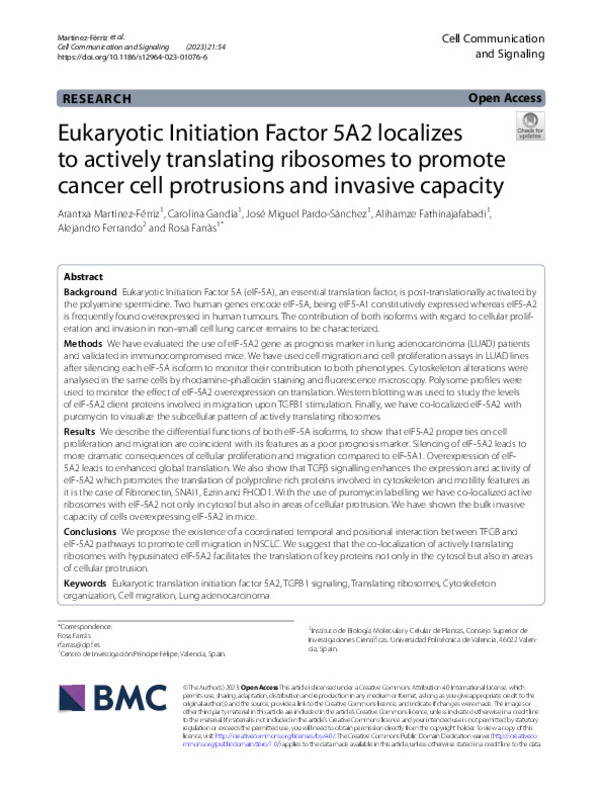JavaScript is disabled for your browser. Some features of this site may not work without it.
Buscar en RiuNet
Listar
Mi cuenta
Estadísticas
Ayuda RiuNet
Admin. UPV
Eukaryotic Initiation Factor 5A2 localizes to actively translating ribosomes to promote cancer cell protrusions and invasive capacity
Mostrar el registro sencillo del ítem
Ficheros en el ítem
| dc.contributor.author | Martínez-Férriz, Arantxa
|
es_ES |
| dc.contributor.author | Gandía, Carolina
|
es_ES |
| dc.contributor.author | Pardo-Sánchez, José Miguel
|
es_ES |
| dc.contributor.author | Fathinajafabadi, Alihamze
|
es_ES |
| dc.contributor.author | Ferrando Monleón, Alejandro Ramón
|
es_ES |
| dc.contributor.author | Farras, Rosa
|
es_ES |
| dc.date.accessioned | 2024-04-23T18:06:33Z | |
| dc.date.available | 2024-04-23T18:06:33Z | |
| dc.date.issued | 2023-03-13 | es_ES |
| dc.identifier.uri | http://hdl.handle.net/10251/203713 | |
| dc.description.abstract | [EN] Background Eukaryotic Initiation Factor 5A (eIF-5A), an essential translation factor, is post-translationally activated by the polyamine spermidine. Two human genes encode eIF-5A, being eIF5-A1 constitutively expressed whereas eIF5-A2 is frequently found overexpressed in human tumours. The contribution of both isoforms with regard to cellular proliferation and invasion in non-small cell lung cancer remains to be characterized. Methods We have evaluated the use of eIF-5A2 gene as prognosis marker in lung adenocarcinoma (LUAD) patients and validated in immunocompromised mice. We have used cell migration and cell proliferation assays in LUAD lines after silencing each eIF-5A isoform to monitor their contribution to both phenotypes. Cytoskeleton alterations were analysed in the same cells by rhodamine-phalloidin staining and fluorescence microscopy. Polysome profiles were used to monitor the effect of eIF-5A2 overexpression on translation. Western blotting was used to study the levels of eIF-5A2 client proteins involved in migration upon TGFB1 stimulation. Finally, we have co-localized eIF-5A2 with puromycin to visualize the subcellular pattern of actively translating ribosomes. Results We describe the differential functions of both eIF-5A isoforms, to show that eIF5-A2 properties on cell proliferation and migration are coincident with its features as a poor prognosis marker. Silencing of eIF-5A2 leads to more dramatic consequences of cellular proliferation and migration compared to eIF-5A1. Overexpression of eIF5A2 leads to enhanced global translation. We also show that TGF ss signalling enhances the expression and activity of eIF-5A2 which promotes the translation of polyproline rich proteins involved in cytoskeleton and motility features as it is the case of Fibronectin, SNAI1, Ezrin and FHOD1. With the use of puromycin labelling we have co-localized active ribosomes with eIF-5A2 not only in cytosol but also in areas of cellular protrusion. We have shown the bulk invasive capacity of cells overexpressing eIF-5A2 in mice. Conclusions We propose the existence of a coordinated temporal and positional interaction between TFGB and eIF-5A2 pathways to promote cell migration in NSCLC. We suggest that the co-localization of actively translating ribosomes with hypusinated eIF-5A2 facilitates the translation of key proteins not only in the cytosol but also in areas of cellular protrusion. | es_ES |
| dc.description.sponsorship | This work was supported by: Fondo de Investigacion Sanitaria, ISCIII, grant number PI20-194, co-funded by ERDF/ESF, "Investing in your future". Ministerio de Educacion, Cultura y Deporte grant FPU13/02755 for JMPS. Asociacion Espanola contra el Cancer, AECC predoctoral grant for AMF. Part of the equipment employed in this work has been funded by Generalitat Valenciana and co-financed with ERDF funds (OP ERDF of Comunitat Valenciana 2014-2020). This article is based upon work from COST Action CA20113 ProteoCure, supported by COST (European Cooperation in Science and Technology). | es_ES |
| dc.language | Inglés | es_ES |
| dc.publisher | BioMed Central | es_ES |
| dc.relation.ispartof | Cell Communication and Signaling | es_ES |
| dc.rights | Reconocimiento (by) | es_ES |
| dc.subject | TGFB1 signaling | es_ES |
| dc.subject | Translating ribosomes | es_ES |
| dc.subject | Cytoskeleton organization | es_ES |
| dc.subject | Cell migration | es_ES |
| dc.subject | Lung adenocarcinoma | es_ES |
| dc.title | Eukaryotic Initiation Factor 5A2 localizes to actively translating ribosomes to promote cancer cell protrusions and invasive capacity | es_ES |
| dc.type | Artículo | es_ES |
| dc.identifier.doi | 10.1186/s12964-023-01076-6 | es_ES |
| dc.relation.projectID | info:eu-repo/grantAgreement/MECD//FPU13%2F02755/ES/FPU13%2F02755/ | es_ES |
| dc.relation.projectID | info:eu-repo/grantAgreement/FEDER//PI20-194//Investing in your future/ | es_ES |
| dc.relation.projectID | info:eu-repo/grantAgreement/COST//CA20113/ | es_ES |
| dc.rights.accessRights | Abierto | es_ES |
| dc.description.bibliographicCitation | Martínez-Férriz, A.; Gandía, C.; Pardo-Sánchez, JM.; Fathinajafabadi, A.; Ferrando Monleón, AR.; Farras, R. (2023). Eukaryotic Initiation Factor 5A2 localizes to actively translating ribosomes to promote cancer cell protrusions and invasive capacity. Cell Communication and Signaling. 21(1). https://doi.org/10.1186/s12964-023-01076-6 | es_ES |
| dc.description.accrualMethod | S | es_ES |
| dc.relation.publisherversion | https://doi.org/10.1186/s12964-023-01076-6 | es_ES |
| dc.type.version | info:eu-repo/semantics/publishedVersion | es_ES |
| dc.description.volume | 21 | es_ES |
| dc.description.issue | 1 | es_ES |
| dc.identifier.eissn | 1478-811X | es_ES |
| dc.identifier.pmid | 36915194 | es_ES |
| dc.identifier.pmcid | PMC10009989 | es_ES |
| dc.relation.pasarela | S\513480 | es_ES |
| dc.contributor.funder | Generalitat Valenciana | es_ES |
| dc.contributor.funder | European Regional Development Fund | es_ES |
| dc.contributor.funder | Asociación Española Contra el Cáncer | es_ES |
| dc.contributor.funder | Ministerio de Educación, Cultura y Deporte | es_ES |
| dc.contributor.funder | European Cooperation in Science and Technology | es_ES |








